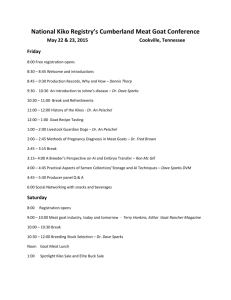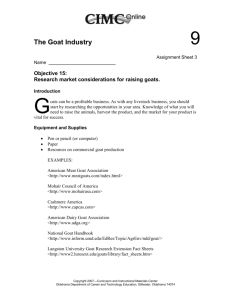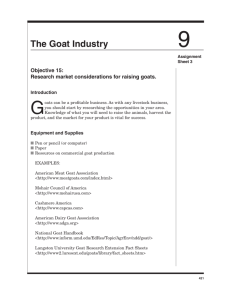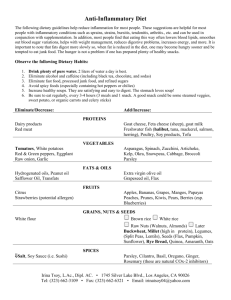Goat Diseases
advertisement
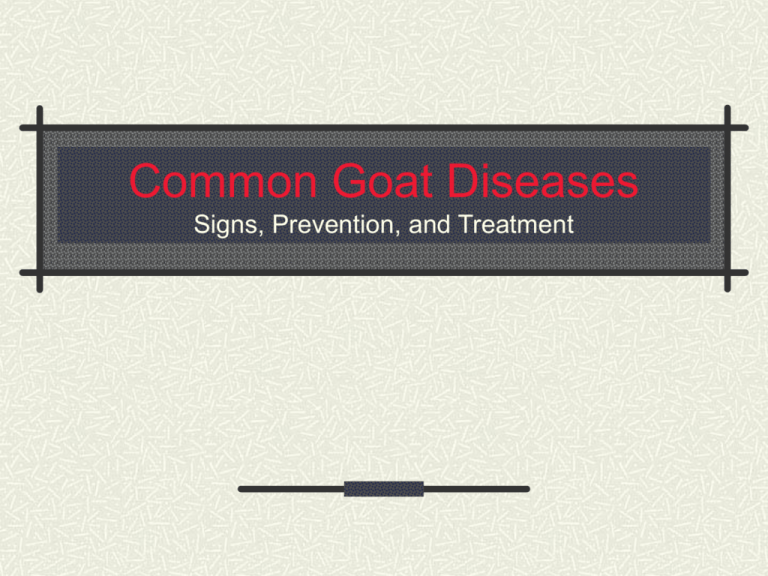
Common Goat Diseases Signs, Prevention, and Treatment Coccidiosis Common in young kids. Flourish in pens with manure buildup. Cause: Coccidia parasites Eradication is difficult once the facilities are infected. Signs – diarrhea, loss of condition, general unthriftiness, poor growth, dehydration, blood in diarrhea, off feed, rapid weight loss, and fever Coccidiosis Treatment – coccidiostats added to water and feed and strict sanitation. Treatment: Treat with Biosol, give orally once a day for 5-7 days. Can also treat with half Corid or Sulmet Also, can put Decox in the mineral Enterotoxaemia Also known as overeating disease. Clostridium perfringens type C & D, primarily type D. Associated with change in quality and quantity of feed. Clostridium perfringens type D bacteria produce poisons when digestive tract deprives them of oxygen Vaccination at weaning and a yearly booster will help in prevention. Enterotoxemia Symptoms: loss of appetite, depressed, high temperature, and watery diarrhea; as enterotoxemia progresses, the goat is unable to stand & will lie on its side making paddling motions. watery diarrhea, depression, convulsions, or death Treatment: Commercially available type C & D antitoxins should be given, plus treatment of acidosis. Acidosis Cause: accidental consumption of large quantities of concentrate foodstuffs Symptoms: depressed, muscle twitching, grinding of the teeth, hangs its head, bloat, and swelling of the left flank Treatment: Stop access to food, drench goat with bicarbonate of soda (2-3 oz), walk the goat and contact veterinarian if needed Pregnancy Toxemia Cause: a metabolic disease in does in late pregnancy, most of the nutrition is going to the kids. Similar to Ketosis. Symptoms: lethargy, loss of appetite, swelling of feet, laying around not wanting to get up, sweet-smelling breath Treatment: Give propylene glycol twice a day along with sodium bicarbonate and water twice a day. Ketosis Cause: ketones accumulate in the blood of lactating does that are unable to obtain large amounts of energy feed Symptoms: off food, milk production decreases, breath smells sweet Treatment: a glucose drench can be given Tetanus Cause: infection of open wounds by Clostridium tetani Symptoms: muscle stiffness causing an unsteady gait, animal looks anxious, convulsions, death results due to the animal being unable to breathe Treatment: Antibiotics- penicillin and antisera can be given but response is poor; flush wound with hydrogen peroxide and treat with penicillin Foot Rot Signs – lameness Prevention – fence goats out of wet, marshy areas where organisms causing foot rot more likely grow and keep hooves trimmed to proper length. Treatment – copper sulfate foot bath and antibiotics. Foot Rot Cause: Flusiformis nodosus infection enters the hoof & causes inflammation of the sensitive laminae Symptoms: mild to severe lameness, animals are reluctant to walk; associated with a foul smell Treatment: Hoof paring in order to remove the underrun hoof. Apply antiseptics to remove any infection. Laminitis Cause: caused by consumption of highly concentrated or lush forage diets; causes inflammation of the skin layers around the hoof Symptoms: lameness, warm feet, stiff gait, prefers to lay down or stay on knees, bloat, diarrhea, & toxemia Treatment: reduced protein/energy diet should be fed & a soft bed should be provided; pain relief drugs, such as Phenylbutazone, is essential; hoof trimming may be necessary to relieve pain Pneumonia Cause: infection of the lung Respiratory Problem Prevention – decrease stress by providing dry, well-ventilated housing with adequate space. Symptoms – unthriftiness, runny nose, loss of appetite and high temp. Pneumonia Symptoms cont.: stops eating, hangs head, sounds congested, rapid or difficulty coughing and breathing Treatment – Antibiotics and correction of predisposing factors with environmental conditions. Oxytetrocycline; if severe, may require veterinary-only drugs Caprine arthritis-encephalitis Also known as CAE Cause: Virus Transmission – ingestion of infected colostrums and milk. Signs – lameness and arthritis, decreased appetite, paralysis of the hind legs, convulsions, seizure, and eventually reaching the area of the brain that controls respiration. Caprine Arthritis Encephalitis (CAE) Symptoms: lameness, weight loss, enlarged knees, pneumonia, and chronic cough Treatment: Isolate and remove the goat from the herd. Treat symptoms but not disease, death is inevitable. Soremouth Contagious ecthyma Signs – difficulty eating, spreading lesions to the does udder Vaccination – use live virus by scarifying the skin and painting on the vaccine. Contagious Pustular Dermatitis (Sore Mouth) Cause: infectious viral disease (affects animals and humans) Symptoms: Pimples around the nose, mouth, eyes, anus, and hoofs. These turn to watery blisters then to sticky, encrusted scabs. The mouth and gums swell. Can cause death if the animal is unable to eat. Soremouth Sore Mouth cont… Treatment: Isolate the goat and use an antibiotic spray or ointment. Vaccination is not recommended. Use a medication with Cephapirin Benzathine. Pinkeye Infectious keratoconjunctivitis. Occurs in warm and hot weather because it is spread be flies and close contact. Highly contagious. Prevention – good sanitation, and fly control. Pinkeye Cause: spread by flies, dust and long grass Symptoms: watery eye, red and cornea is cloudy, sensitive to light Treatment: flush eyes with penicillin or Oxytetracycline for a few days and also isolate the animal from other animals. Broad spectrum antibiotics, sprays and powders. Remove from sunlight and cover with patch. White Muscle Disease (WMD) Seen in kids less than one week to three months in age. This disease is normally noted in rapidly growing, heavily muscled kids that were born to does that consumed rations deficient in vitamin E and/or selenium. Signs – weakness, poor suckling reflex, stiffness, arched back, “sawhorse” stance, respiratory distress, and sudden death. Prevention – Supplementation of vitamin E and selenium in pregnant does. Treatment – injection of selenium and 68 IU of vitamin E. If the heart has been affected treatment is rarely successful. White Muscle Disease Cause: deficiency of Vitamin E and Selenium Symptoms: Stiffness, weakness, and trembling, unable to use back legs, can result in death Treatment: give selenium with vitamin E Scours More common in young kids. Caused by coccidia, E. coli, worms, salmonella, and viruses. Signs – anorexia (won’t eat), high temp, weakness, and watery or pasty feces. Prevention – good sanitation. Treatment – antibiotics, intestinal astringents (bolus or fluid to decrease contractions), and fluid and electrolyte therapy. Chlamydial Abortions Also known as enzootic abortion. Chlamydial abortions occur in the last stage of gestation. After a does aborts from this disease they form immunity to it and will not abort on subsequent pregnancies. Signs – does rarely show visible signs before occurrence. Prevention – vaccinate does prior to breeding. Treatment – tetracycline antibiotics Polioencephalomalcia (Goat Polio) This is a Thiamine (Vitamin B 1) deficiency. Caused by feeding too much grain and too little roughage. Symptoms – excitability, “stargazing”, uncoordinated staggering and weaving, circling, diarrhea, and muscle tremor. Polioencephalomalcia (Goat Polio) Symptoms cont.: muscle rigidity, diarrhea, circling, staggering or weaving, excitability, apparent blindness, eyes moving fast, convulsions, and fever, death usually occurs within 24-72 hours Treatment:Give thiamine and penicillin; if animal is unable to eat, give Revive orally and water several times a day. thiamine injection given intravenously if possible Foot and Mouth Viral disease of clovenhoofed animals. NOTE: If foot and mouth disease is suspected contact a veterinarian immediately. Foot & Mouth Disease Symptoms: blisters on the lips, tongue, teats, or the coronary band of the hoof; can become lame and have excessive salivation Treatment: Prevent this before it occurs; destroy any animal that is exposed Treatment – NONE; Animals exposed to the disease are destroyed Johne’s Disease Cause: Mycobacterium johnei bacterium in the intestine; causes thickening of the intestine Symptoms: poor condition, scouring becomes more frequent with bubbles of gas in droppings, weakness, & thirst increases Treatment: Destroy animal as soon as possible to prevent spreading. Johne’s Disease Chronic incurable infection of the intestines by Mycobacterium johnei bacterium. Causes a thickening of the intestine. Signs – loss of condition, occasional scouring, weakness, and thirst may increase. Treatment – None. Slaughter animal as soon as possible to prevent spread to other animals. Blackleg Cause: soil-borne bacterium, Clostridium chauvei. Symptoms: This disease occurs rapidly in affected animals and can cause death before the owner notices any sickness. May cause high fever, depressed appetite, depression, lameness, and swelling of the head and in the muscle on various parts of the body Treatment: Treat with penicillin or other antibiotics in large doses. Have a veterinarian drain the affected area of the swelled head. Bloat Cause: gorging on anything unsuitable (example: wet grass pastures or raiding food bin) Symptoms: Tightly inflated flanks, collapse, and misery Treatment: Drench goat with vegetable or other oil (6-8 oz for adults & 2+ oz for kids), walk goat around, massage flanks. Contact veterinarian if this does not help. Brucella Melitensis Cause: Organism excreted in milk, urine, and feces. Causes an infection of the placenta and udder. Symptoms: Abortion will occur in last 2 months of pregnancy Treatment: Vaccinations are available to prevent it, but generally the herd is slaughtered. Caseous Lymphadenitis (CL) Cause: Bacteria enters the goat through breaks in skin or mucus membranes and localizes in lymph node. Symptoms: Abscesses of the lymph glands. Treatment: Have a Vet test to see if the abscess is CL. Isolate the goat, lance the abscess and remove discharge, then treat with iodine several times. Destroy all discharge. Caseous Lymphadenitis (CL) Colic Cause: affects young kids when diets are changed (such as mixing milk replacer at wrong concentration) Symptoms: restlessness, stands with back arched or hind feet placed well back, and cries out Treatment: If pain does not pass in a few hours, give ½ pint of vegetable oil (for adults and less for kids) along with 1 glass of spirits in 2 glasses of water, repeat this hourly until the pain stops Floppy Kid Syndrome Cause: believed to be caused by too rich milk or associated with E. coli Symptoms: depression, weakness of limbs which progresses to flaccid paralysis, and goat may also have a drunken appearance Treatment: Remove from source of milk for 24 to 36 hours. Dissolve 1 tsp of sodium bicarbonate in water & give 20-50cc orally, allowing the kid to swallow during administration. Repeat this procedure 1,3,6,12 hours after initial treatment. Also give electrolytes until returning to milk & give wide spectrum antibiotic to prevent secondary bacterial infections. Indigestion Cause: failure of normal ruminal movement; often associated with high intake of concentrate foodstuffs Symptoms: off of food Treatment: Usually recovers in 2 days; sodium bicarbonate can be given orally if there are acid conditions in the rumen. Listeriosis Cause: caused by Listeria monocytogenes; feeding silage, sudden changes in kind of feed, parasitism, dramatic changes in weather, & advanced stages of pregnancy can be the onset of listeriosis Symptoms: depression, little appetite, fever, rigid neck pulled toward flank, facial paralysis on one side, move in one direction only, drooling, & abortions Treatment: Procaine penicillin every 6 hours for 3 to 5 days, then daily for 7 days Mastitis Cause: inflammation of the udder; associated with germs Symptoms: udder is hot, hard and tender, loss of appetite, bruised looking udder Treatment: Antibiotics CD antitoxin, Poly Serum, Penicillin, Banamine, and Nuflor Mycotoxin Cause: fungus growth in old hay or feed poisons the animal Symptoms: depression, anorexia, excessive salivation, convulsions, and an arched back Treatment: Varies with the source of the problem. Remove bad feed and administer activated charcoal to inhibit additional uptake of toxin from the gut. Mineral oil may also be helpful. Navel Ill Cause: dirty environment infecting the navel cord Symptoms: swollen, painful, red navel in young kid Treatment: Antibiotics, clean the area around the navel with antiseptic iodine, remove scabs and drain any pus pockets. Urinary Calculi Cause: A hard mass of mineral salts in the urinary tract caused by a dietary mineral imbalance. Urinary calculi is usually seen in bucks. Symptoms: straining to urinate, restlessness, vocal signs of pain, pawing at the ground, and looking at its abdomen Treatment: Consult your veterinarian. Stone (suture 1 inch in length) Chorioptic Mange Cause: Chorioptes caprae; infests the skin of the lower leg Symptoms: itchiness and small scabs Psoroptic Mange Cause: Psoroptes caprae; infests the ears Symptoms: head shaking and scratching Treatment: Use gamma benzene hexachloride and gammexane Sarcoptic Mange Cause: Saroptes scabei; burrows in the skin and lays their eggs in tunnels Symptoms: itching, red and hairless around the eyes, ears, and nose, and the skin becomes raised Treatment: Veterinary treatment is required due to infestation being passed to other goats. Demodectic Mange Cause: Demodex caprae; invades hair follicles and sebaceous glands of the skin Symptoms: small lumps in skin, maybe cyst like or like a bag of fluid Treatment: Due to response to treatment being poor, it is best to consult your veterinarian. Ringworms Cause: Fungal condition Symptoms: gray/white crusty appearance on skin, thickened skin and hairs thin or absent, enlargement of affected areas Treatment: Fungicides used as a liquid dressing. Use any of the following: 0.5% Lime sulfur 1:10 bleach 1:300 Captan 1% Betadine Use these daily for 5 days and then weekly. Ringworm Bottle Jaw Cause: blood-sucking worms Symptoms: lower face and jaw swell and gums may not be normal in color Treatment: Worm the goat with strong medicine every 11 days, for 3 times. May also need to give iron and vitamins. Lungworms Cause: worms inhabit air passage & cause inflammation Symptoms: chronic cough Treatment: drench with dewormer Lice Cause: parasite Symptoms: irritation, rubbing, bald patches, itching, usually occurs in the winter Treatment: powders, sprays, or dips can be used Gastro-intestinal roundworms Infests stomach and intestines Symptoms: diarrhea, weight loss, & anemia Treatment: drench with dewormer Tapeworms Cause: inhabits the small intestine Symptoms: Passing of tapeworm segments in feces in young goats during the summer months Treatment: anthelminticalbendazole can be used; oral niclosamide is highly effective Conclusion Strict sanitation is necessary to prevent diseases. Although sanitation requires time and money, it is time and money well spent since prevention of the diseases is more economical than treatment. The housing for goats plus their food and water must be kept clean and dry.
